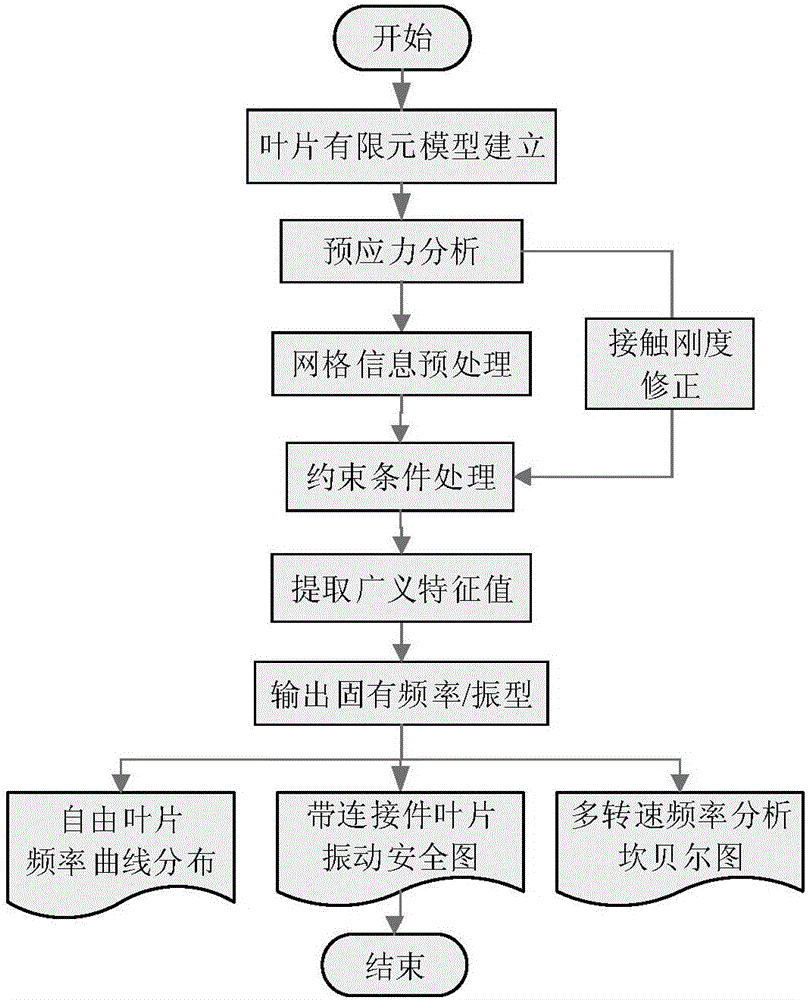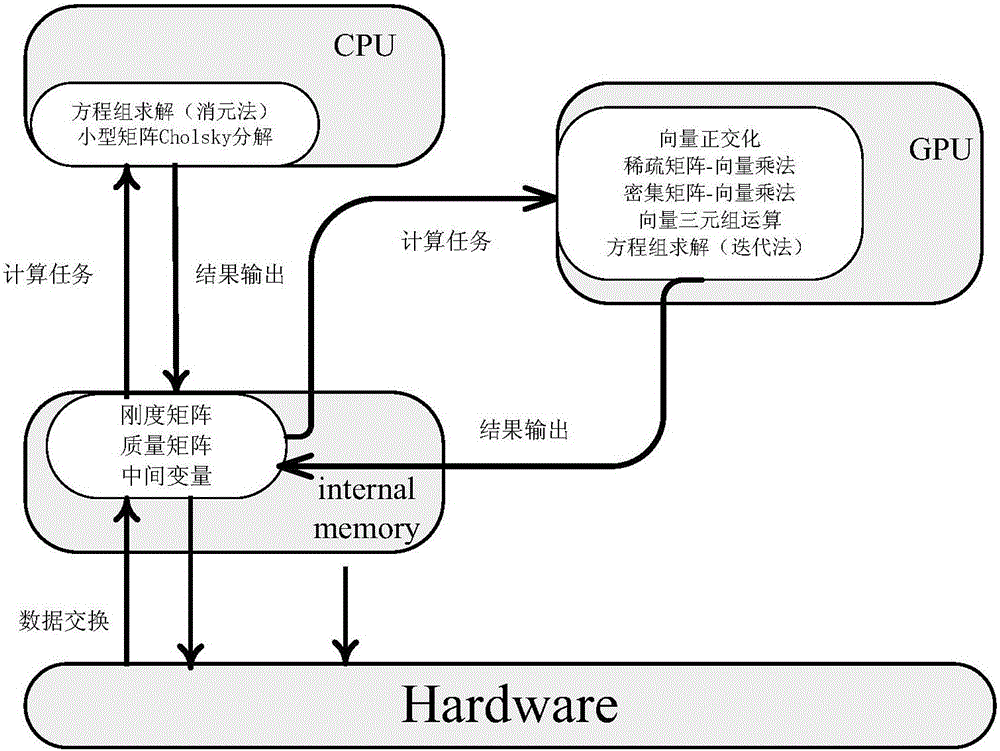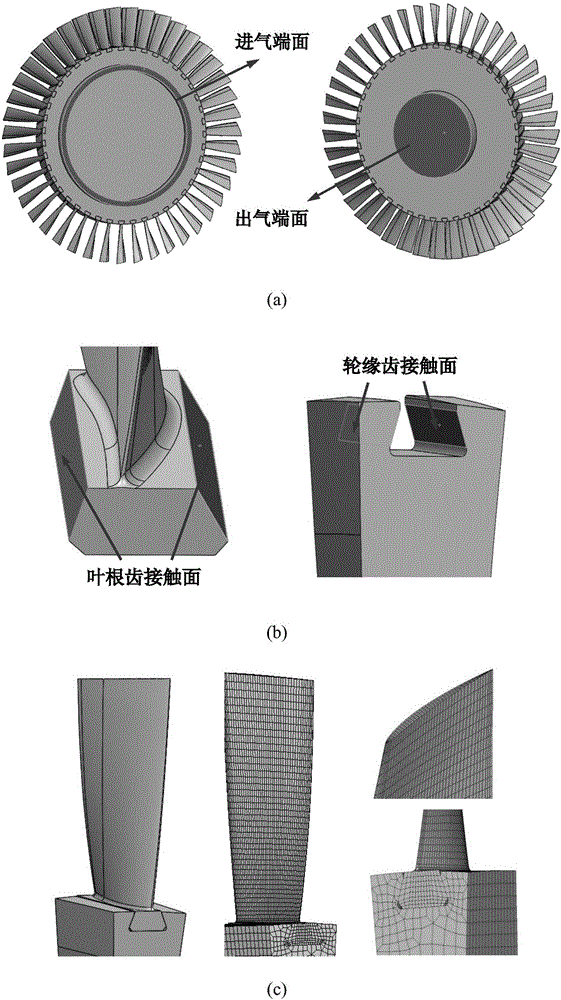CPU+GPU heterogeneous parallel computing based natural frequency characteristic analysis method for turbomachinery blade
A turbomachinery, natural frequency technology, applied in the direction of calculation, geometric CAD, design optimization/simulation, etc., can solve the problems of cumbersome operation, uncomfortable calculation amount, etc., to achieve the effect of improving calculation speed and reducing calculation time
- Summary
- Abstract
- Description
- Claims
- Application Information
AI Technical Summary
Problems solved by technology
Method used
Image
Examples
example 1
[0104] 实例一以某整圈自由叶片(不存在连接件)为例,三维模型为具有燕尾型叶根和轮缘,共43个叶片, image 3 中(a)给出了该叶片的整圈几何模型,(b)为燕尾型的叶根-轮缘接触面示意图,叶片及轮缘的材料参数见表1。网格剖分在ANSA软件中完成, image 3 中(c)局部的有限元网格模型,网格主体采用8节点六面体单元,在叶根过渡部分采用四面体以及退化单元进行网格划分,整体共具有760885个单元,728400个节点。
[0105] 表1某自由叶片和轮缘的材料属性
[0106]
[0107] 对叶片施加工作转速为3000r / min的离心载荷,进行预应力分析;单元矩阵在CPU(IntelXeonE5-2650)和GPU(NvidiaTeslaK20c)上计算,并在CPU上组装总矩阵;施加边界条件为轮缘进气端面的切向和轴向刚性位移约束,出气端面的切向位移刚性约束和轴向位移弹性约束,轮缘接触面和叶根接触面网格节点进行合并;提取前250阶特征值和特征向量,计算固有频率值并判断其振动类型如表2,绘制振型云图如 Figure 4 ,获得其中单个自由叶片的振动类型,最后绘制动频值分布图如 Figure 5 .
[0108] 该问题在32G内存,IntelXeonE5-2650 / NvidiaTeslaK20c单节点计算机上运行,ANSYS计算时间2763s,约为45分钟,VIB程序计算时间为954s,约16分钟;相对于ANSYS,VIB程序计算的加速比可以达到2.90倍,该方法加速效果良好。
[0109] 表2整圈自由叶片固有动频(前250阶)
[0110]
example 2
[0112] 实例二以某带有连接件(围带和阻尼块)的整圈叶片为例,三维模型采用菌型叶根,通过阻尼块以及围带发生接触作用将整圈叶片连接起来,共92个叶片, Image 6 中(a)给出了该叶片的整圈几何模型,(b)为连接件(围带和阻尼块)的示意图,叶片及轮缘的材料参数见表3。网格剖分在ANSA软件中完成, Image 6 中的(c)为叶片局部的有限元网格模型,主体采用8节点六面体单元,在叶根和围带的过渡部分采用四面体以及退化单元进行网格划分,整体模型的节点总数为1176877,单元总数为1337312。
[0113] 表3某带有连接件叶片和轮缘的材料属性
[0114]
[0115] 对叶片施加工作转速为3000r / min的离心载荷,设置围带和阻尼块的接触摩擦系数0.2,进行预应力分析;单元矩阵在CPU(IntelXeonE5-2650)和GPU(NvidiaTeslaK20c)上计算,并在CPU上组装总矩阵;施加边界条件为轮缘进气端面的切向和轴向刚性位移约束,出气端面的切向位移刚性约束和轴向位移弹性约束,轮缘接触面和叶根接触面网格节点进行合并,阻尼块和围带间的接触刚度按照接触面间的接触力和相对位移进行修正;提取前100阶特征值和特征向量,计算固有频率并判断振动阶次和节径数,汇总如表4,计算固有振型并输出振型云图如 Figure 7 ;最后绘制工作转速下3000r / min的振动安全图如 Figure 8 . 与实例一采用相同配置计算机,ANSYS计算时间为3234s,VIB程序计算时间为873.57s,并行程序计算加速比可以达到3.7左右,该方法加速效果明显。
[0116] 表4某整圈带连接件叶片固有频率值
[0117]
[0118]
PUM
 Login to View More
Login to View More Abstract
Description
Claims
Application Information
 Login to View More
Login to View More - R&D
- Intellectual Property
- Life Sciences
- Materials
- Tech Scout
- Unparalleled Data Quality
- Higher Quality Content
- 60% Fewer Hallucinations
Browse by: Latest US Patents, China's latest patents, Technical Efficacy Thesaurus, Application Domain, Technology Topic, Popular Technical Reports.
© 2025 PatSnap. All rights reserved.Legal|Privacy policy|Modern Slavery Act Transparency Statement|Sitemap|About US| Contact US: help@patsnap.com



